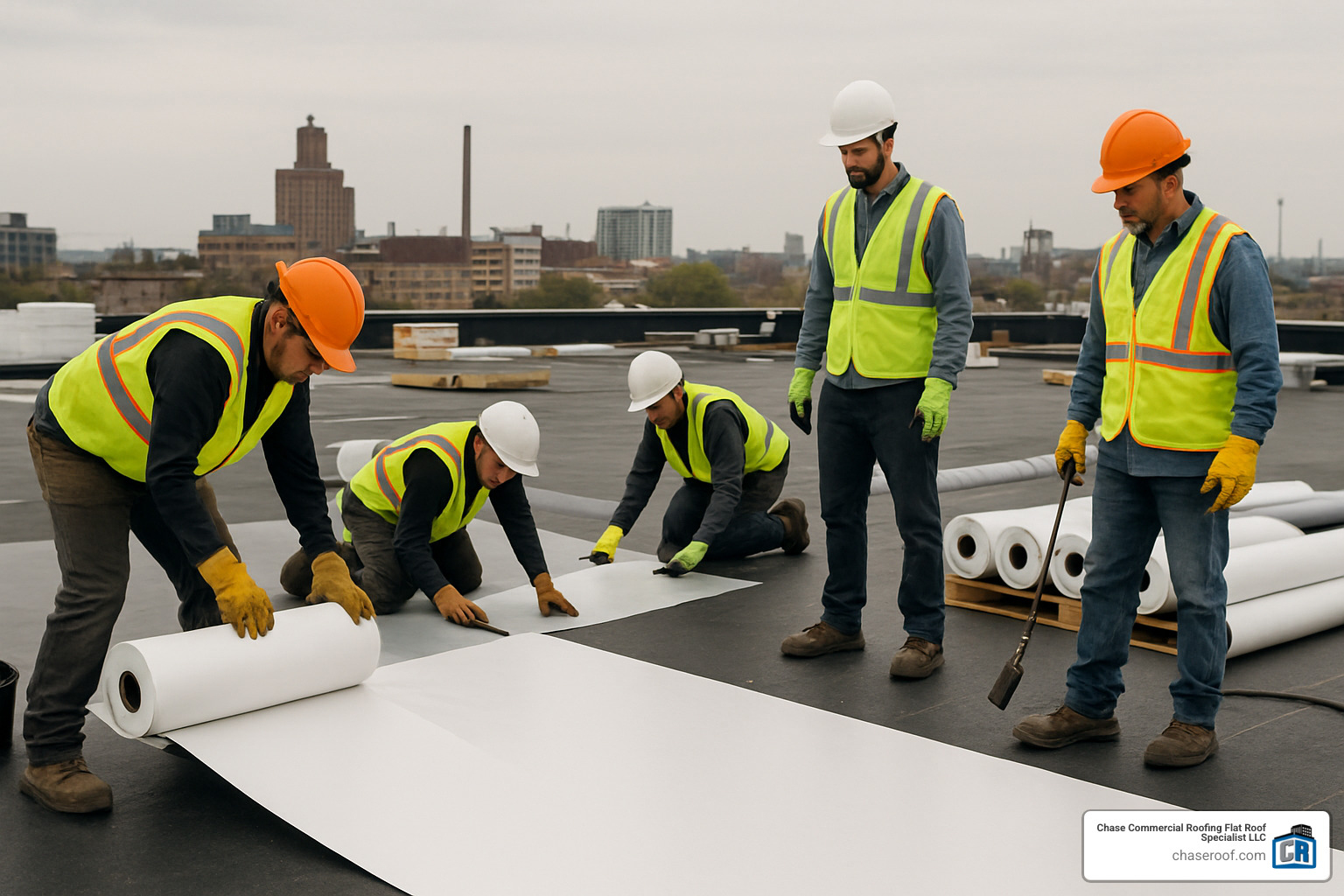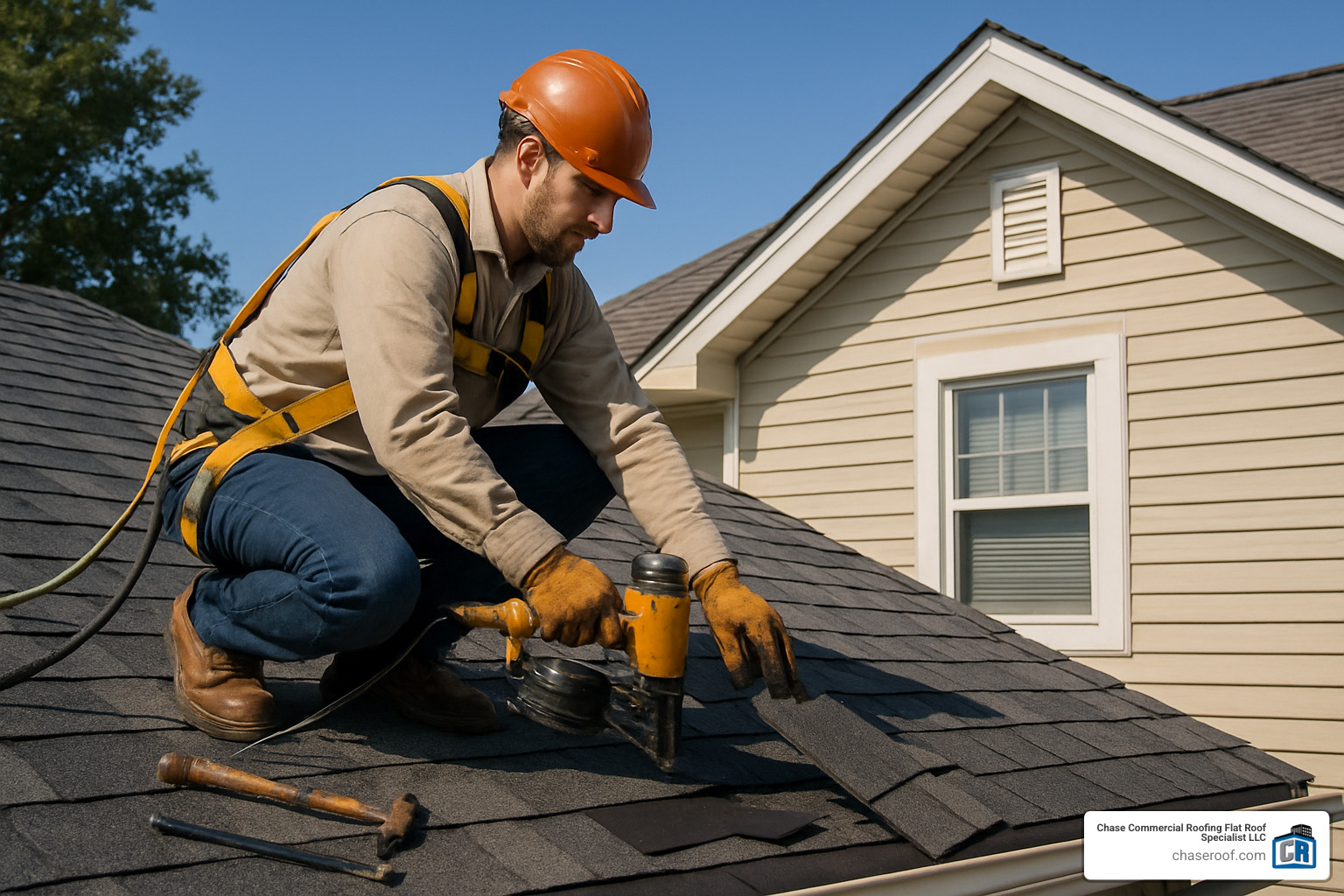Why Precision Matters in Flat Roof Projects
Flat roof calculator tools help commercial property owners accurately measure roof area and estimate project costs. Here’s what you need to know:
- Basic Formula: Length × Width = Base Area (add 10% for waste)
- For Low-Slope Roofs: Base Area ÷ cosine(roof angle) = Actual Surface Area
- Average Costs: $5-$10 per square foot ($8,000-$16,000 for typical commercial project)
- Common Materials: EPDM ($4-$8/sq ft), TPO ($3.50-$6.88/sq ft), PVC ($4-$7.75/sq ft)
When managing a commercial property in New Jersey, few things are as critical as the integrity of your flat roof. Whether you’re planning a replacement, repair, or evaluating maintenance costs, knowing the exact dimensions of your roof is the foundation of every roofing decision you’ll make.
Gone are the days of climbing ladders with tape measures and notepads. Today’s digital flat roof calculators streamline the process, providing instant, accurate measurements that help you budget properly and avoid material waste.
For New Jersey businesses, where weather extremes from summer heat to winter snow put extra demands on commercial roofing, precision isn’t just convenient—it’s essential for long-term roof performance and cost control.
I’m John Chase, President of Chase Commercial Roofing Flat Roof Specialist LLC with over 30 years of experience helping New Jersey businesses accurately assess their roofing needs using flat roof calculators and professional measurement techniques.

Flat Roofs 101: Why Accurate Area Matters
Let’s be honest – flat roofs aren’t actually flat. They typically have a gentle slope of about 1/4 inch per foot (roughly 2%) that most people wouldn’t notice at a glance. This subtle pitch isn’t just a design quirk – it’s essential for directing water toward drains and preventing puddles that can damage your commercial property.
When measuring your roof for a project, this slight angle makes a real difference. A good flat roof calculator takes this pitch into account, ensuring you don’t underestimate the true surface area. I’ve seen plenty of New Jersey business owners surprised when they find their “10,000 square foot” roof actually needs material for 10,200 square feet or more.
This precision directly impacts your bottom line in several ways:
- Material ordering becomes foolproof – no mid-project emergency runs for more supplies or wasted materials eating into your budget
- Drainage plans work as intended – proper calculations help identify potential problem areas before they become expensive repairs
- Structural integrity stays sound – knowing the exact load requirements means no surprises during snow season
- Energy bills stay lower – precise measurements ensure proper insulation coverage

Here in New Jersey, where we can get everything from heavy snowfall to summer downpours, proper drainage isn’t just important – it’s essential. Our coastal location means we sometimes face tropical storm remnants that can dump inches of rain in hours.
The Cost of Miscalculating
I’ve seen the fallout from inaccurate measurements more times than I care to remember. When measurements are off, the consequences ripple through your entire project:
First comes the dreaded material shortage. Your contractor calls with the news that they’ve run out of roofing membrane with 15% of the job still uncovered. Now your partially completed roof sits vulnerable to the elements while you wait for additional materials to arrive.
Then there’s the scheduling nightmare. The crew that was supposed to finish Friday now needs to return next week, extending the disruption to your business operations.
The budget impact hits next. Those additional materials? They’re now rush-ordered at premium prices. The extra labor days? Not in the original estimate.
Key Differences from Pitched Roofs
Commercial flat roofs operate on completely different principles than the pitched roofs you see on most homes:
While a typical residential roof might have a steep 30° pitch, your commercial flat roof likely has a gentle 2-9° slope. This subtle incline is easy to overlook but crucial for accurate calculations.
Drainage systems on flat roofs are more complex and intentional. Rather than simply letting gravity do the work down a steep slope, flat roofs direct water to specific drainage points through slight elevation changes.
Weight-bearing considerations matter more on flat roofs. Many New Jersey businesses place HVAC equipment, satellite dishes, or even rooftop break areas on their flat roofs.
Rooftop utilization opportunities are another key difference. With the push for sustainability in New Jersey, many businesses are installing solar arrays or green roofing systems that transform unused roof space into energy-generating or environmentally friendly assets.
Flat Roof Calculator: Your Digital Tape Measure
A flat roof calculator isn’t just a nice-to-have tool—it’s an essential asset for anyone managing commercial roofing projects. Think of it as the modern equivalent of that trusty tape measure, but with superpowers that save you time, money, and plenty of headaches.
When I first started in the roofing business, we did everything by hand—climbing ladders with notepads getting soaked in the rain, scribbling measurements, and then hunching over a desk trying to make sense of it all. Today’s digital tools have transformed this process entirely.
These calculators shine by eliminating those all-too-human math errors that can cascade into major project issues. What used to take my team hours now happens in minutes, giving you instant results you can trust. They’re smart enough to factor in those easily overlooked roof features like penetrations and slope variations that make a big difference in material needs.
For New Jersey business owners watching their bottom line, this accuracy translates directly to better budgeting. No more padding estimates “just to be safe” or facing unexpected material shortages mid-project.
Most online roof surface area calculators follow a straightforward approach. They collect your roof’s basic dimensions and apply mathematical formulas to determine the total area. For flat roofs specifically, this typically means measuring length and width, accounting for any slope, adjusting for features like skylights or HVAC units, and applying that critical waste factor—usually about 10%—for material overlaps and cuts.
At Chase Commercial Roofing, we’ve helped countless New Jersey businesses accurately assess their roofing needs using these tools, often alongside our professional measurement services. For more details about our comprehensive flat roof solutions, visit our flat roof solutions page.
Hitting the Numbers: Using the Flat Roof Calculator Step-by-Step
Using a flat roof calculator effectively is all about following a clear process:
First, gather those basic measurements—at minimum, you’ll need length and width. For complex roof shapes, break everything down into rectangular sections and measure each separately.
Be consistent with your units—whether you prefer feet, inches, meters, or yards. Mixing units is one of the most common causes of calculation errors I see. Input your dimensions carefully, calculating each section individually for multi-section roofs before adding them together.
Even with “flat” roofs, don’t forget to account for slope. Most commercial flat roofs have a slight pitch of 0.25″/12″ to 0.5″/12″—small but significant when calculating total area. Always apply that 10% waste factor to account for material overlaps, cuts around penetrations, and installation waste.

Let me share a quick real-world example: If your Jersey City commercial building measures 100 feet by 50 feet, your base area would be 5,000 square feet. With that standard 10% waste factor, you’d need materials to cover approximately 5,500 square feet.
Troubleshooting Flat Roof Calculator Results
If your numbers seem off, don’t panic. There are several common issues to check:
Mixed units can dramatically skew results—I once had a client accidentally enter length in feet and width in inches, resulting in an estimate that was off by a factor of 12! Missing offsets for penetrations is another frequent oversight; forgetting to subtract areas for large skylights or add area for parapet walls affects accuracy significantly.
Watch out for incorrect pitch entry—some calculators ask for pitch in degrees, others in rise/run format. Entering in the wrong format will cause substantial errors. Overlooking sections happens more often than you’d think, especially with complex roofs featuring multiple levels.
If you’re unsure about your results, I always recommend running the calculations through a second calculator for verification. Better yet, contact us at Chase Commercial Roofing for a free roof assessment. We provide professional measurements for commercial properties throughout New Jersey, giving you peace of mind that your project is starting on solid ground.
Measuring Like a Pro Before You Click “Calculate”
Getting accurate measurements is the foundation of using any flat roof calculator effectively. At Chase Commercial Roofing, we’ve refined our measurement techniques over decades of serving New Jersey businesses.
The days of climbing up with just a tape measure are behind us. Today, we use a combination of tools to ensure precision:
-
Laser measuring devices: These give us spot-on readings even across long distances – a huge improvement over tape measures that can sag or bend.
-
Drone technology: For those sprawling commercial properties in Woodland Park and beyond, our drone surveys capture every detail without anyone having to walk the entire roof.
-
Satellite imagery: Sometimes we’ll use satellite images for preliminary measurements, especially for buildings with difficult access.
Safety always comes first in our book. We never take measurements without proper fall protection equipment – no roof calculation is worth risking someone’s wellbeing. That’s why we often recommend letting our professionals handle the measuring part for you.
When we measure a commercial roof, we break it down into simple shapes. That complex roof? It’s just a collection of rectangles and triangles when you look at it the right way.
Don’t forget those easily overlooked elements that can throw off your calculations:
Overhangs extend beyond your building walls and need to be included in your measurements. Parapets require additional material to cover properly. Expansion joints need special attention during installation.
| Measurement Tool | Imperial Units | Metric Units | Best For |
|---|---|---|---|
| Tape Measure | Feet & Inches | Meters & Centimeters | Small to medium roofs |
| Laser Distance Meter | Feet (decimal) | Meters | Medium to large roofs |
| Drone Survey | Feet (decimal) | Meters | Complex or large roofs |
| Building Plans | Varies | Varies | Pre-construction estimates |
Accounting for Pitch, Parapets & Penetrations
Even “flat” roofs aren’t perfectly flat – and that slight angle matters when calculating your materials. Here’s how we handle these calculations:
First, we determine the rise-over-run ratio (typically between 0.25/12 and 0.5/12 for commercial flat roofs). We convert this to degrees (a 0.25/12 pitch equals about 1.19 degrees), then apply the slope multiplier formula: 1 ÷ cosine(angle).

Parapets and penetrations add another layer of complexity. For parapet walls, we measure both height and length, then multiply to find the additional square footage needed. HVAC units require measurements around all four sides of each curb. Skylights actually reduce your material needs, so we subtract their area from the total.
Double-Checking with a Secondary Flat Roof Calculator
Trust but verify – that’s our approach to roof calculations. We always recommend running your numbers through a second flat roof calculator to catch any potential errors.
Some reliable online options include the Roofing Calculator at Calculator.net. Many manufacturers also offer their own calculators, though keep in mind these might be designed to sell specific products.
If your results from different calculators vary by more than 1-2%, something’s probably off in your measurements or inputs. This small step of verification can save you thousands in potential material shortages or overages.
At Chase Commercial Roofing, we’re happy to help verify your measurements or take care of the entire process for you. Our team provides free estimates for commercial properties throughout Woodland Park and surrounding New Jersey communities.
From Area to Budget: Material & Cost Estimation
Now that you’ve got your roof’s square footage figured out, let’s talk dollars and cents. Turning your flat roof calculator results into a realistic budget is pretty straightforward:
Total Project Cost = Roof Area × Cost per Square Foot
But as any New Jersey business owner knows, the devil’s in the details. That cost-per-square-foot figure swings widely based on several factors:
The material you choose makes a huge difference. Whether you go with the durability of EPDM rubber, the energy efficiency of TPO, the chemical resistance of PVC, the traditional reliability of modified bitumen, or the longevity of metal will significantly impact your bottom line.
Your insulation needs also play a major role. Higher R-values mean better energy efficiency but also higher upfront costs. For many of our New Jersey clients, the long-term energy savings often justify the initial investment, especially with our hot summers and cold winters.
Removing existing roofing is another consideration that many building owners overlook. The more layers that need to come off, the more labor and disposal costs you’ll incur.
Here in New Jersey, the installed costs (materials and labor combined) typically look like this:
- EPDM (rubber): $4-$8 per square foot
- TPO (thermoplastic): $3.50-$6.88 per square foot
- PVC: $4-$7.75 per square foot
- Modified Bitumen: $3-$6 per square foot
- Metal Roofing: $7-$13 per square foot
These prices include basic insulation, but may increase with higher R-value requirements or complex installations. If you’re looking into a full replacement, our commercial roof replacement page offers more detailed information.
Quick Cost Formula
After 30+ years in the business, I’ve developed a formula that gives my clients a pretty reliable ballpark figure:
Budget Estimate = (Area × Base Cost) + (Tear-off Cost × Area) + Permit Fees + Contingency
Let me break that down:
* Base Cost covers your material and standard installation
* Tear-off Cost typically runs $0.45-$2.00 per square foot (depending on existing material and layers)
* Permit Fees generally range from $500-$1,500 for commercial projects in our area
* Contingency should be 10-15% of your subtotal (because surprises happen!)
Comparing Flat Roofing Materials
I always tell my clients that choosing the right material is about balancing initial cost against long-term value. Here’s how the most common commercial roofing materials stack up:
| Material | Lifespan | Installed Cost ($/ft²) | Pros | Cons |
|---|---|---|---|---|
| EPDM | 15-25 years | $4-$8 | Affordable, flexible, easy repairs | Less puncture resistant, typically black (heat absorption) |
| TPO | 15-20 years | $3.50-$6.88 | Energy efficient, white surface, heat-welded seams | Newer material with evolving formulations |
| PVC | 20-30 years | $4-$7.75 | Highly durable, chemical resistant, heat-welded seams | Higher cost, environmental concerns |
| Modified Bitumen | 15-25 years | $3-$6 | Multi-ply protection, traditional installation | Labor intensive, less environmentally friendly |
| Metal | 30-50 years | $7-$13 | Extremely durable, long-lasting, recyclable | Highest initial cost, requires skilled installation |
For most of our New Jersey commercial clients, we recommend either EPDM or TPO systems. They offer the best balance of cost, performance, and durability for our climate. EPDM in particular has proven itself time and again in our harsh Northeastern weather cycles. You can learn more about this reliable material on our EPDM roofing page.
Beyond the Calculator: Project Planning & Professional Help
While a flat roof calculator gives you essential area and budget information, there’s more to planning a successful roofing project. Think of your calculator as just the first tool in your commercial roofing toolbox.
For New Jersey business owners, considering these additional factors can save you time and money in the long run:
-
Solar readiness: If solar panels are in your future, you’ll need to ensure your roof structure can handle the additional weight and that your membrane choice is compatible with panel installation systems.
-
Green roof potential: Living roofs are becoming increasingly popular in New Jersey, offering excellent stormwater management and energy efficiency benefits.
-
Maintenance planning: Different roofing systems have unique maintenance needs. EPDM might need different attention than TPO or PVC. Planning for these maintenance requirements now can extend your roof’s lifespan significantly.
-
Energy efficiency goals: A cool roof can cut your summer cooling costs dramatically in New Jersey’s hot, humid summers. The right roofing choice today could mean lower utility bills for years to come.

Technology has come a long way in recent years. Some advanced tools now combine flat roof calculators with AI-powered imagery analysis that can evaluate satellite or drone photos of your roof. These smart systems can identify potential problem areas, analyze drainage patterns, and even suggest optimal equipment placement.
But even the fanciest digital tools have their limits. No calculator can assess structural integrity, spot hidden moisture damage, or evaluate the condition of existing roofing components. This is where human expertise becomes invaluable.
If you’re dealing with an emergency situation that needs immediate attention, don’t hesitate to contact our emergency roof repair services for rapid response throughout New Jersey.
When to Call a Pro in Woodland Park
Your flat roof calculator is a great starting point, but certain situations definitely call for professional assessment:
Structural concerns raise immediate red flags. If you notice sagging, hear unusual noises during heavy rain, or suspect deck damage, it’s time for an expert evaluation before proceeding with any project.
Drainage problems that persist are another warning sign. Standing water that doesn’t dissipate within 48 hours after rainfall indicates issues with slope or drain placement that require professional analysis.
Code compliance questions can be tricky to steer on your own. New Jersey building codes have specific requirements for commercial roofing that vary by municipality. A local professional understands these nuances.
Insurance claims almost always benefit from professional documentation. If your roof project involves an insurance claim for storm or other damage, having an expert assessment strengthens your position.
At Chase Commercial Roofing, we provide comprehensive roof assessments for commercial properties throughout New Jersey. Our team can verify your calculator measurements and identify issues that might affect your roofing project. For more information about our repair services, visit our commercial roof repair page.
Frequently Asked Questions about Flat Roof Calculators
How does roof pitch affect a “flat” roof calculation?
Despite their name, flat roofs aren’t perfectly flat. Commercial flat roofs typically have a slight pitch of 1/4″ to 1/2″ per foot (about 1.2-2.4 degrees) to ensure proper drainage.
This slight slope actually increases your roof’s surface area compared to its footprint. While the difference might seem tiny—just 0.02-0.09%—it adds up on larger roofs. Imagine a 20,000 square foot commercial building in East Rutherford with a 1/2″ per foot slope. The actual surface area would be about 20,018 square feet—that’s enough extra material to make a difference in your budget.
Quality flat roof calculators include a slope adjustment feature to account for this difference. When planning your project, I always recommend using the slope-adjusted figure for more accurate material estimates.
Can the same calculator be used for residential and commercial flat roofs?
While the math works the same way for any roof, commercial flat roofs have unique complexities that basic residential calculators often don’t address properly.
Commercial projects simply operate on a different scale. They’re typically much larger, making even small calculation errors multiply into significant problems. They also have more “stuff” on the roof—numerous HVAC units, vents, and other penetrations that must be properly accounted for.
Other commercial-specific features include parapet walls (which require additional material for proper flashing), complex internal drainage systems, and specialized materials not commonly used in residential applications.
For these reasons, I strongly recommend using calculators specifically designed for commercial applications. Better yet, consult with commercial roofing specialists like us at Chase Commercial Roofing for truly accurate assessments.
How do I factor in skylights, chimneys, or rooftop HVAC units?
Roof penetrations require special attention in your calculations—they’re not just holes to subtract!
Start by measuring the base area of each penetration (length × width for rectangular features) and subtract this from your total roof area. This gives you the net area requiring roofing material. But don’t stop there!
You’ll need to add back the perimeter flashing requirements. Measure around each penetration and multiply by the required flashing height (typically 8-12 inches). For example, a 4′ × 4′ skylight has a base area of 16 square feet (subtract this) but adds a perimeter of 16 linear feet. With flashing extending 8 inches up, that’s an additional 10.67 square feet of material needed.
HVAC units sitting on curbs need similar treatment, but remember to account for the curb height. A typical 4′ × 4′ HVAC unit on a 12″ curb would require approximately 16 square feet of flashing material (4 sides × 4 feet × 1 foot).
Conclusion
The flat roof calculator isn’t just a convenient tool—it’s your secret weapon for taking control of your commercial roofing project from start to finish. When you have accurate measurements in hand, everything downstream improves: you order the right amount of materials, your budget stays on target, and those expensive mid-project surprises become much less likely.
For business owners and property managers here in New Jersey, this kind of precision pays dividends. Our unique climate challenges—from heavy winter snow loads to summer heat waves and everything in between—put special demands on commercial roofs. When you combine these environmental factors with today’s rising construction costs, getting your measurements right the first time becomes even more critical.
At Chase Commercial Roofing Flat Roof Specialist LLC, we’ve built our reputation by blending modern calculation tools with good old-fashioned roofing expertise. Our team has spent decades serving commercial clients throughout Passaic, Newark, Paterson, Jersey City, Hackensack, Woodland Park, East Rutherford, and beyond—we understand the specific challenges New Jersey businesses face when it comes to their roofing systems.
Whether you’re planning ahead for a complete roof replacement, addressing troublesome leaks, or evaluating the roofing system on a potential property purchase, our goal is to help you steer the process with confidence. The journey from accurate measurements to successful project completion doesn’t have to be stressful. For a deeper look at the flat roofing systems we specialize in, visit our flat roof systems page.
Ready to move beyond calculations and take the next step with your commercial roofing project? We’d be happy to provide a free, no-obligation estimate. Our team will verify your measurements, thoroughly assess your roof’s current condition, and develop a detailed proposal specifically custom to your building’s needs and your budget constraints. Contact us to schedule your appointment, and let’s get started on protecting your commercial investment the right way.







